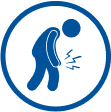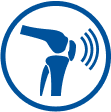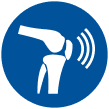What is OA?
A joint has cartilage, synovial fluid and other components that help protect and cushion the bones.
- Cartilage is the tough elastic material that covers, protects, and cushions the ends of bones to enable nearly frictionless joint movement
- Synovial fluid lubricates the joint and acts as a shock absorber
OA is a chronic degenerative joint disease that usually worsens slowly over a period of months or years.
- OA occurs when the cartilage gradually deteriorates. Eventually, your bones rub against each other, causing pain, joint stiffness and swelling
- OA affects the entire joint, also causing changes in the bone and connective tissues and inflammation of the joint lining

How common is OA?
OA is the most common form of arthritis. It affects more Canadians than all other forms of arthritis combined.
4+ million
Canadians are living with OA

Symptoms
Early on, symptoms may tend to come and go, but the intensity of pain can increase over time.

Joint pain
(the intensity of pain can increase over time, as OA is a progressive disease)

Joint stiffness
(such as in the morning)

Joint swelling

Joint dysfunction
(due to pain or reduced movement)

Joint crepitus
(grinding sensation or ‘creaking’ sound when the joint moves)
42%
of working-age Canadians (20–64 years) reported being out of work or school due to OA
(compared to 19% of the general population)
Joints affected

SYNVISC® is a temporary replacement and supplement for synovial fluid used to treat pain associated with OA of the knee, hip, shoulder and ankle, allowing more extensive movement of the joint.
Synvisc-One® is a temporary replacement and supplement for synovial fluid used to treat pain associated with OA of the knee, allowing more extensive movement of the joint.
Risk factors
Risk factors that may increase your chances of developing OA include:

Age
(risk increases with age, but is not inevitable)

Excess body weight
(places additional stress on weight-bearing joints, increasing risk of injury and rate of joint degeneration)

Previous joint injury and/or repeated stress on a joint

Female sex
(females are more likely to develop OA)
OA is most certainly not an “old person’s disease”.
Nearly 1 in 3 with OA report being diagnosed before the age of 45.
Diagnosis
There is no single test used to diagnose OA. Some of the ways your doctor may diagnose OA and rule out other potential diagnoses include:
- Medical history
- Physical exam
- Lab tests
- Diagnostic imaging (e.g., X-ray)
COMING SOON!
Complete the Interactive Joint Pain Self-Assessment Tool and take your results to your doctor to help guide your discussion.
There are different OA-related pain treatment options to consider.
Home > Understanding osteoarthritis > What is OA?
